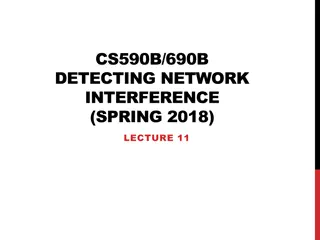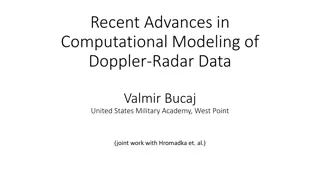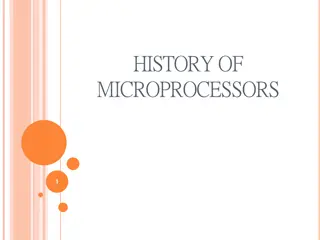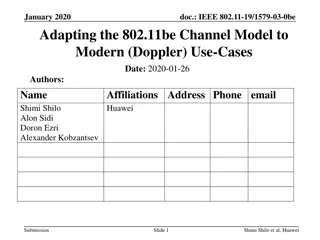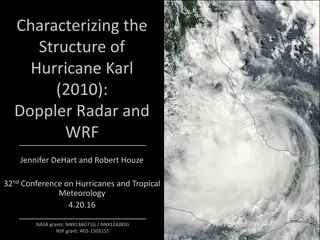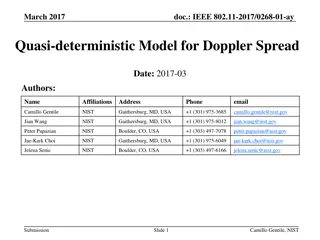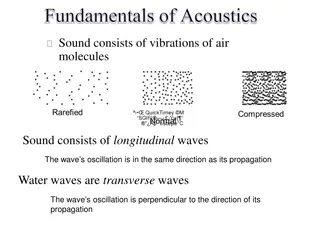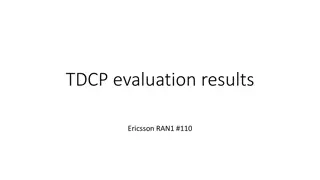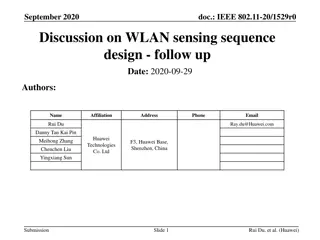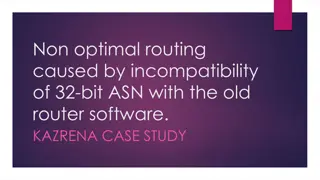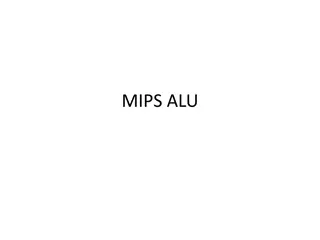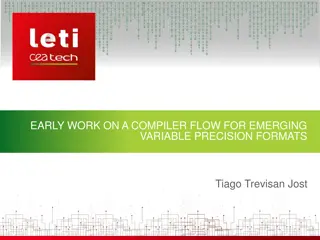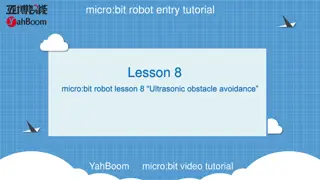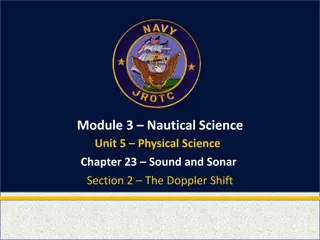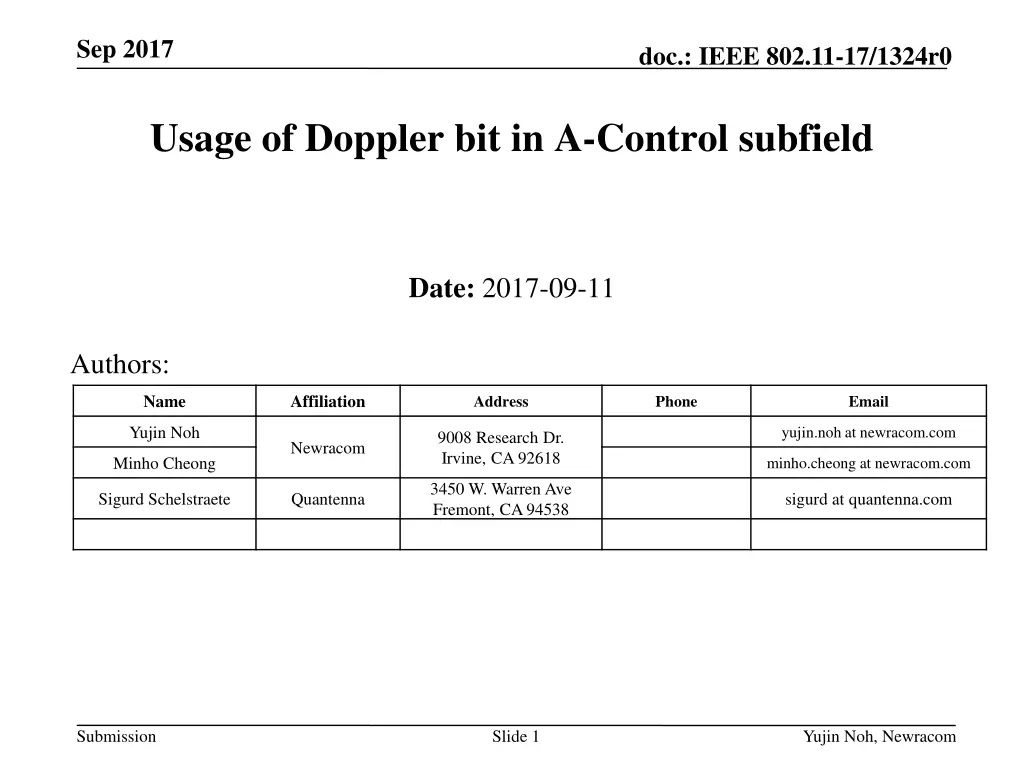
Usage of Doppler Bit in IEEE 802.11-17/1324r0 for 11ax Mid-Amble Design
Learn about the utilization of the Doppler bit in the A-Control subfield of IEEE 802.11-17/1324r0 document for the Mid-Amble design in 11ax, including its significance in different scenarios and the impact on PHY/MAC design philosophy. Explore examples and considerations related to Doppler information and its implementation in WLAN technology.
Download Presentation

Please find below an Image/Link to download the presentation.
The content on the website is provided AS IS for your information and personal use only. It may not be sold, licensed, or shared on other websites without obtaining consent from the author. If you encounter any issues during the download, it is possible that the publisher has removed the file from their server.
You are allowed to download the files provided on this website for personal or commercial use, subject to the condition that they are used lawfully. All files are the property of their respective owners.
The content on the website is provided AS IS for your information and personal use only. It may not be sold, licensed, or shared on other websites without obtaining consent from the author.
E N D
Presentation Transcript
Sep 2017 doc.: IEEE 802.11-17/1324r0 Usage of Doppler bit in A-Control subfield Date: 2017-09-11 Authors: Name Affiliation Address Phone Email Yujin Noh yujin.noh at newracom.com 9008 Research Dr. Irvine, CA 92618 Newracom Minho Cheong minho.cheong at newracom.com 3450 W. Warren Ave Fremont, CA 94538 Sigurd Schelstraete Quantenna sigurd at quantenna.com Submission Slide 1 Yujin Noh, Newracom
Sep 2017 doc.: IEEE 802.11-17/1324r0 Background (1/2) For 11ax, the Mid-amble design has been introduced by setting Doppler bit in HE-SIG-A to 1. Usage 1) When NSYM is larger than the mid-amble duration (M), proper value and how to signal of M and corresponding equations (NMA) at TX and (NMA, NSYMandTPE) RX have been suggested [1][2][3]. Usage 2) When NSYM is not larger than M, extra usage of Doppler bit in HE-SIG-A was discussed in order to indicate whether channel is time varying for RX [4]. Submission Slide 2 Yujin Noh, Newracom
Sep 2017 doc.: IEEE 802.11-17/1324r0 Background (2/2) There are some examples of the proper PPDU (e.g. short packets) to support Usage 2. HE PS-poll frame HE ACK/BA frame HE (QoS) null data frame We will revisit three short packets later to analysis on the operation of Usage 2. Submission Slide 3 Yujin Noh, Newracom
Sep 2017 doc.: IEEE 802.11-17/1324r0 Considerations 802.11 PHY/MAC design philosophy, Normative behavior of both AP and STA are clearly expected when receiving the information on SIG field(s). The SIG consists of control information fields to interpret and decode the received PPDU. Even in exception, at least that control information should be effective and valid when needed for RX. WLAN has never allowed cross-layer distribution of the needed information for a single function. Even in exceptions (e.g. PAID, Color), it has been allowed only in a case that the corresponding function of MAC information is supposed to be totally transferred to PHY layer in order to significantly reduce the decoding time Even though RX obtains Doppler information in PHY, transmit address in MAC of the received PPDU is still important to know which TX is under Doppler circumstance for the next transmission. Submission Slide 4 Yujin Noh, Newracom
Sep 2017 doc.: IEEE 802.11-17/1324r0 Analysis of Usage 2 examples (1/3) A HE PS-poll frame [4] may be a short control frame Since the PS-poll frame is not a stand-alone frame, it usually requires the pre-defined procedure between AP and STA first. The STA sends a frame to AP to indicate power management is enabled. It remains awaken until AP transmits Ack/BA before the STA goes into the sleep state. When the STA is in 802.11 power management, it sends the HE PS-poll frame to request AP to send a buffered frame indicated by Beacon frame. AP shall acquire the transmit address in MAC header to know which STA is under time varying channel AP may send the buffered data with Mid-amble inserted in response for the STA known as being suffering Doppler-driven environment. Submission Slide 5 Yujin Noh, Newracom
Sep 2017 doc.: IEEE 802.11-17/1324r0 Analysis of usage 2 examples (2/3) A HE ACK/BA frame could be a short control frame. Contradiction between decoding data successfully vs. urgent need indicating Doppler in responding ACK/BA frame. It is not likely urgent that next upcoming data frame should be more secured than the current data frame we ve just successfully received Or in order to make next data frame more reliable, it might be transmitted with conservative M and MCS very inefficiently 1 bit Doppler indication does not provide enough information for efficient transmission AP shall acquire the transmit address in MAC header to know which STA is under time varying channel The receiver may transmit the next data frame with unnecessarily large overhead (e.g. lowest MCS, mid-amble inserted every 10 OFDM symbols) for the STA. Submission Slide 6 Yujin Noh, Newracom
Sep 2017 doc.: IEEE 802.11-17/1324r0 Analysis of usage 2 examples (3/3) The HE (QoS) null data frame could be another candidate Generally STA transmits the Null data frame to initiate the power saving mode by setting power management subfield to 1 to minimize the PPDU overhead . In the similar way, STA may send it with HE SU PPDU by setting Doppler bit to 1 anytime as stand-alone frame. AP shall acquire the transmit address in MAC header to know which STA is under time varying channel. AP may send the data with Mid-amble inserted in response for the STA known as being suffering Doppler-driven environment Slide 7 Submission Yujin Noh, Newracom
Sep 2017 doc.: IEEE 802.11-17/1324r0 Design requirements In order for time-varying channel information to be useful enough for the next transmission of the RX, two aspects need to be taken into account. Minimize the restriction to the HE PPDU that set the Doppler indication to 1. Considering the robustness to Doppler in [1], allowing the short packet limited by M value seems to be unreasonable and inefficient. To identify the transmit address in MAC header of received HE PPDU is unavoidable procedure to transmit the immediate/valid feedback to right target eventually. Doppler bit in HE-SIG-A is not enough information to take this benefit. PHY info seems to be coupled with MAC info eventually to support Usage 2. Submission Slide 8 Yujin Noh, Newracom
Sep 2017 doc.: IEEE 802.11-17/1324r0 WHY MAC field design is better It minimizes the restriction to the HE PPDU setting Doppler to 1 for the same purpose of Usage 2. M in HE-SIG-A is not a critical value anymore to indicate whether channel is time varying or not. Given flexible range of PPDU length [1], when a STA recognizes Doppler circumstance, it can help RX provide the immediate/valid feedback to the proper STA efficiently. Optimize the next transmission by adding useful information (e.g. recommend proper MCS) on top of Doppler information. Given following 802.11 PHY/MAC design philosophy, it identifies which TXs suffer from Doppler circumstance by all corresponding MAC information together. Submission Slide 9 Yujin Noh, Newracom
Sep 2017 doc.: IEEE 802.11-17/1324r0 Examples of using MAC field A-Control subfield (1/2) Aggregated Control subfield 1 bit 1 bit VHT HT Control 1 Control N Doppler bit in A-Control subfield could be an alternative approach. Decoding the MAC header of the received PPDU is a fundamental procedure to get transmit address. Receiver may not take any immediate advantage just after having Doppler information of HE-SIG-A field in PHY. Adding HT-Control field (4 bytes) is not a big burden to keep reasonable packet length Submission Slide 10 Yujin Noh, Newracom
Sep 2017 doc.: IEEE 802.11-17/1324r0 Examples of using MAC field A-Control subfield (2/2) Opt.1 Support a new Control ID (e.g. 7) as Doppler mode 4 bits 1 bit X bit(s) Control ID (e.g. 7) Doppler Reserved Enough reserved states in Control ID in A-Control subfield Given short length of Control subfield, the A-Control subfield allows additional Control subfield (e.g. OM Control subfield, HE link adaptation Control subfield etc) on top of Doppler mode. Opt. 2 Add Doppler information to the existing Control subfield. Need minor updates. Any existing Control subfields could add 1 bit Doppler info if needed. HLA is preferable. HLA is optional feature and even though RX receives MFB info, it is not required to do something immediately. E.g.) Unsolicited MFB of HE link adaptation [5] (see Appendix) whose format is not fixed yet could be a good candidate. Recommended NSS, HE-MCS, DCM info can be delivered together to combat fast time-varying channel Submission Slide 11 Yujin Noh, Newracom
Sep 2017 doc.: IEEE 802.11-17/1324r0 Protocol-wise behaviors when using A-Control subfield Doppler in A-Control subfield set to 0 Doppler in A-Control subfield set to 1 Mid-amble inserted AP STA1 STA2 STA2 measuring fast time-varying channel STA2 measuring stable channel For example, with STA2 measuring time-varying channel, it may transmit the PPDU(s) by setting Doppler in A-Control subfield to 1. The PPDU may consist of payload with fairly low MCS and reasonable length considering simulation results in [1]. RX obtains transmit address and Doppler information in MAC header of the PPDU together. Given the space available in A-Control subfield, additional information (recommend MCS etc) could be delivered to make the next transmission efficient for RX Submission Slide 12 Yujin Noh, Newracom
Sep 2017 doc.: IEEE 802.11-17/1324r0 Comparison Doppler info in [4] Doppler info in 11/17-1324 HE-SIG-A of HE SU (ER) PPDU and HE MU PPDU in PHY A-Control subfield in MAC header of any HE PPDUs Information location Use reserved subfield (1 bit) of existing Control subfields. Use reserved Control ID. How to signal Reuse Doppler of HE-SIG-A field 1) Doppler info of HE-SIG-A in PHY. 2) Transmit address in MAC header. PHY info is on hold until MAC info is available, and then coupled with MAC info eventually to support Usage 2. 1) Doppler info of A-Control subfield in MAC header. 2) Transmit address in MAC header. Only MAC info is used to support Usage 2. Required information to support the purpose of Usage 2 Information transmitted together with Doppler info for TX s benefit N/A Recommended MCS, DCM, etc Coverage/Condition e.g.) how much restricted data/management frames with reasonable packet length based on [1]. Short packet with NSYM M Submission Slide 13 Yujin Noh, Newracom
Sep 2017 doc.: IEEE 802.11-17/1324r0 Summary Analyze and compare two approaches to indicate whether channel is time varying for RX We prefer to add Doppler subfield in HLA subfield. B0 B2 B3 B6 B7 B8 B9 B15 NSS HE-MCS DCM Doppler Reserved Bits: 1(#961 9) 3 4 1 7 Figure 9-15e Control Information subfield format when Control ID subfield is 2 Submission Slide 14 Yujin Noh, Newracom
Sep 2017 doc.: IEEE 802.11-17/1324r0 Strawpoll #1 Do you agree to split the text proposal corresponding to extra use of HE-SIG-A from 11-17/0995r2? Y/N/A Submission Slide 15 Yujin Noh, Newracom
Sep 2017 doc.: IEEE 802.11-17/1324r0 Reference [1] 11-17/0960r0 Follow-up on Doppler Design in 802.11ax [2] 11-17/0994r0 Midamble Design [3] 11-17/0998r1 Nsym and Tpe at RX side for Midamble design [4] 11-17/1021r0 Usage of Doppler Bit in 11ax [5] 11-17/1054r0 lb225-cr-27-13-presentation Submission Slide 16 Yujin Noh, Newracom
Sep 2017 doc.: IEEE 802.11-17/1324r0 APPENDIX Submission Slide 17 Yujin Noh, Newracom
Sep 2017 doc.: IEEE 802.11-17/1324r0 Current Link Adaptation Operation 1) MCS update period, in which channel/link quality is approximately the same Link adaptation update period1) Link adaptation update period1) New Link adaptation update period MRQ MRQ Node 1 Node 2 Solicited MFB *Unsolicited MFB Solicited MFB Rapid change in channel conditions detected Node 1 is un-aware those changes Considering usual link quality, Node 1 could request MRQ periodically to catch up the channel update (Solicited MFB) There may be rapid change in channel condition which detected only by Node 2. Additional attenuation loss could happen due to change in hand grip of device, user movement, etc Without MRQ by Node 1, Node 2 may send MCS back of the received frame which experiences channel changes for better link quality between Node 1 and Node 2. (Unsolicited MFB) Submission Slide 18 Yujin Noh, Newracom
Sep 2017 doc.: IEEE 802.11-17/1324r0 Current Status of D1.4 [5] HE Link adaption (HLA) control has only minimum subfields for link adaptation Lack of details of HE link adaptation protocols Many fields required for LA are undefined yet Submission Slide 19 Yujin Noh, Newracom




